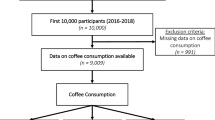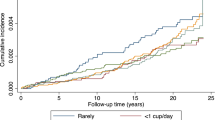Abstract
Background/Objectives:
Most of the studies that have investigated the association between coffee consumption and hepatic steatosis have been experimental and small-scale clinical studies. As a result, epidemiological studies are scarce. To clear the association, we conducted a cross-sectional study and investigated the effects of coffee consumption with those of green tea consumption.
Subjects/Methods:
We analyzed 1024 Japanese male workers. The diagnosis of hepatic steatosis was based on ultrasonography. We divided coffee and green tea consumption into the following three categories: non-drinker; 1–2 cups/day and ⩾3 cups/day. To investigate the association between hepatic steatosis and coffee or green tea consumption, we calculated the odds ratio (OR) and adjusted the means of leptin levels on each severity of hepatic steatosis.
Results:
A total of 265 of our subjects (25.9%) were diagnosed with hepatic steatosis. The ORs of the group of subjects who drank >3 cups of coffee/day was significantly lower compared with that of the noncoffee drinker group (OR 0.59, 95% confidence intervals 0.38–0.90, P=0.03). Although there was a significant difference between coffee consumption and leptin level only in the asymptomatic group, we found a decreasing trend in the asymptomatic and moderate–severe hepatic steatosis group. We did not find the same relationships in green tea consumption.
Conclusions:
Although we did not find an association between hepatic steatosis and green tea consumption, coffee may have beneficial effects on hepatic steatosis. In addition, we produced one possible hypothesis that coffee consumption negatively associates with leptin levels in hepatic steatosis.
This is a preview of subscription content, access via your institution
Access options
Subscribe to this journal
Receive 12 print issues and online access
$259.00 per year
only $21.58 per issue
Buy this article
- Purchase on Springer Link
- Instant access to full article PDF
Prices may be subject to local taxes which are calculated during checkout

Similar content being viewed by others
References
Freedman ND, Park Y, Abnet CC, Hollenbeck AR, Sinha R . Association of coffee drinking with total and cause-specific mortality. N Engl J Med 2012; 366: 1891–1904.
Gutierrez-Grobe Y, Chavez-Tapia N, Sanchez-Valle V, Gavilanes-Espinar JG, Ponciano-Rodriguez G, Uribe M et al. High coffee intake is associated with lower grade nonalcoholic fatty liver disease: the role of peripheral antioxidant activity. Ann Hepatol 2012; 11: 350–355.
Molloy JW, Calcagno CJ, Williams CD, Jones FJ, Torres DM, Harrison SA . Association of coffee and caffeine consumption with fatty liver disease, nonalcoholic steatohepatitis, and degree of hepatic fibrosis. Hepatology 2012; 55: 429–436.
Suzuki Y, Miyoshi N, Isemura M. . Health-promoting effects of green tea. Proc Jpn Acad Ser B Phys Biol Sci 2012; 88: 88–101.
Bae KC, Park JH, Na AY, Kim SJ, Ahn S, Kim SP et al. Effect of green tea extract/poly-gamma-glutamic acid complex in obese type 2 diabetic mice. Diabetes Metab J 2013; 37: 196–206.
Bhardwaj P, Khanna D . Green tea catechins: defensive role in cardiovascular disorders. Chin J Nat Med 2013; 11: 345–353.
Yuan JM, Sun C, Butler LM . Tea and cancer prevention: epidemiological studies. Pharmacol Res 2011; 64: 123–135.
Fiorini RN, Donovan JL, Rodwell D, Evans Z, Cheng G, May HD et al. Short-term administration of (-)-epigallocatechin gallate reduces hepatic steatosis and protects against warm hepatic ischemia/reperfusion injury in steatotic mice. Liver Transpl 2005; 11: 298–308.
Imai K, Nakachi K . Cross sectional study of effects of drinking green tea on cardiovascular and liver diseases. BMJ 1995; 310: 693–696.
Day CP, James OF . Steatohepatitis: a tale of two "hits"? Gastroenterology 1998; 114: 842–845.
Tilg H, Moschen AR . Evolution of inflammation in nonalcoholic fatty liver disease: the multiple parallel hits hypothesis. Hepatology 2010; 52: 1836–1846.
Dos Santos Moraes A, Pisani LP, Corgosinho FC, Testa Carvalho LO, Masquio DC, Jamar G et al. The role of leptinemia state as a mediator of inflammation in obese adults. Horm Metab Res 2013; 45: 605–610.
Russell VL 2014. lsmeans: Least-Squares Means. R package version 2.12. http://CRAN.R-project.org/package=lsmeans.
Imamura Y, Uto H, Hiramine Y, Hosoyamada K, Ijuin S, Yoshifuku S et al. Increasing prevalence of diabetes mellitus in association with fatty liver in a Japanese population. J Gastroenterol 2013; 49: 1406–1413.
Omagari K1, Kadokawa Y, Masuda J, Egawa I, Sawa T, Hazama H et al. Fatty liver in non-alcoholic non-overweight Japanese adults: incidence and clinical characteristics. J Gastroenterol Hepatol 2002; 17: 1098–1105.
Bravi F, Bosetti C, Tavani A, Gallus S, La Vecchia C . Coffee Reduces Risk for Hepatocellular Carcinoma: An Updated Meta-Analysis. Clin Gastroenterol Hepatol 2013; 11: 1413–1421.
Bravi F, Bosetti C, Tavani A, Bagnardi V, Gallus S, Negri E et al. Coffee drinking and hepatocellular carcinoma risk: a meta-analysis. Hepatology 2007; 46: 430–435.
Xiao J, Ho CT, Liong EC, Nanji AA, Leung TM, Lau TY et al. Epigallocatechin gallate attenuates fibrosis, oxidative stress, and inflammation in non-alcoholic fatty liver disease rat model through TGF/SMAD, PI3 K/Akt/FoxO1, and NF-kappa B pathways. Eur J Nutr 2014; 53: 187–199.
Jin X, Zheng RH, Li YM . Green tea consumption and liver disease: a systematic review. Liver Int 2008; 28: 990–996.
Imatoh T, Tanihara S, Miyazaki M, Momose Y, Uryu Y, Une H . Coffee consumption but not green tea consumption is associated with adiponectin levels in Japanese males. Eur J Nutr 2011; 50: 279–284.
Murase T, Misawa K, Minegishi Y, Aoki M, Ominami H, Suzuki Y et al. Coffee polyphenols suppress diet-induced body fat accumulation by downregulating SREBP-1c and related molecules in C57BL/6J mice. Am J Physiol Endocrinol Metab 2011; 300: E122–E133.
Tsochatzis EA, Papatheodoridis GV, Archimandritis AJ . Adipokines in nonalcoholic steatohepatitis: from pathogenesis to implications in diagnosis and therapy. Mediators Inflamm 2009; 2009: 831670.
Das S, Kumar A, Seth RK, Tokar EJ, Kadiiska MB, Waalkes MP et al. Proinflammatory adipokine leptin mediates disinfection byproduct bromodichloromethane-induced early steatohepatitic injury in obesity. Toxicol Appl Pharmacol 2013; 269: 297–306.
Katayama M, Donai K, Sakakibara H, Ohtomo Y, Miyagawa M, Kuroda K et al. Coffee consumption delays the hepatitis and suppresses the inflammation related gene expression in the Long-Evans Cinnamon rat. Clin Nutr 2014; 33: 302–310.
Yamashita K, Yatsuya H, Muramatsu T, Toyoshima H, Murohara T, Tamakoshi K . Association of coffee consumption with serum adiponectin, leptin, inflammation and metabolic markers in Japanese workers: a cross-sectional study. Nutr Diabetes 2012; 2: e33.
Sinha RA, Farah BL, Singh BK, Siddique MM, Li Y, Wu Y et al. Caffeine stimulates hepatic lipid metabolism by the autophagy-lysosomal pathway in mice. Hepatology 2014; 59: 1366–1380.
Salomone F, Li Volti G, Vitaglione P, Morisco F, Fogliano V, Zappalà A et al. Coffee enhances the expression of chaperones and antioxidant proteins in rats with nonalcoholic fatty liver disease. Transl Res 2014; 163: 593–602.
Mubarak A, Hodgson JM, Considine MJ, Croft KD, Matthews VB . Supplementation of a high-fat diet with chlorogenic acid is associated with insulin resistance and hepatic lipid accumulation in mice. J Agric Food Chem 2013; 61: 4371–4378.
Meli R, Mattace Raso G, Irace C, Simeoli R, Di Pascale A, Paciello O et al. High fat diet induces liver steatosis and early dysregulation of iron metabolism in rats. PLoS One 2013; 8: e66570.
Cornelis MC, El-Sohemy A . Coffee, caffeine, and coronary heart disease. Curr Opin Clin Nutr Metab Care 2007; 10: 745–751.
Acknowledgements
This work was supported by Grant of The Clinical Research Promotion Foundation (2010, 2014). We thank public health nurse Yuko Shibata for her invaluable help.
Author information
Authors and Affiliations
Corresponding author
Ethics declarations
Competing interests
The authors declare no conflict of interest.
Rights and permissions
About this article
Cite this article
Imatoh, T., Kamimura, S. & Miyazaki, M. Coffee but not green tea consumption is associated with prevalence and severity of hepatic steatosis: the impact on leptin level. Eur J Clin Nutr 69, 1023–1027 (2015). https://doi.org/10.1038/ejcn.2015.23
Received:
Revised:
Accepted:
Published:
Issue Date:
DOI: https://doi.org/10.1038/ejcn.2015.23



